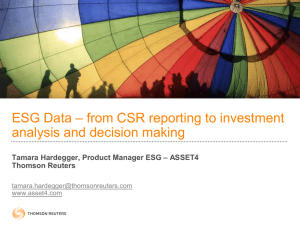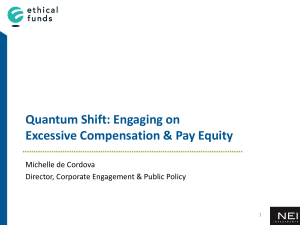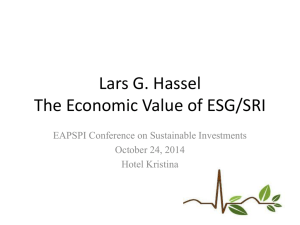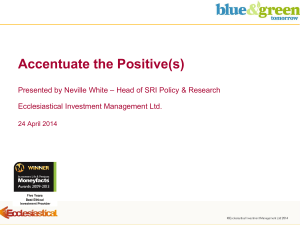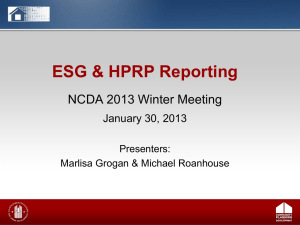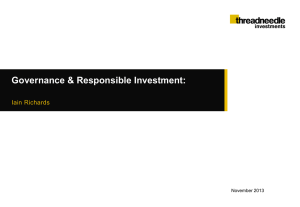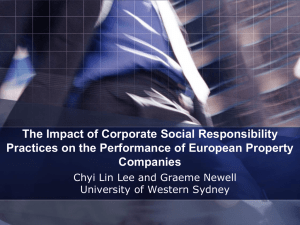Gail Doolin - Quaffers.org
advertisement
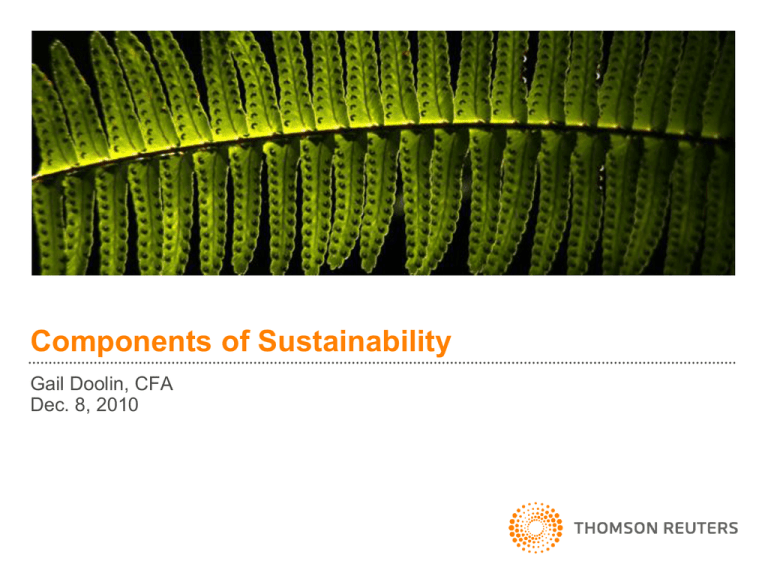
Components of Sustainability Gail Doolin, CFA Dec. 8, 2010 Agenda • Overview of Sustainability • ASSET4 ESG Data at Thomson Reuters • Correlation of ESG scores with CDS spreads & Earnings Surprises • ESG scores as Predictor of Future Returns • Combining ESG with Earnings Quality Model • Q&A Sustainability - Finally Moving Mainstream? “Are all Components of ESG Scores Equally Important?” The Financial Professionals Post, July 14, 2010 “A Quant’s Take on ESG” responsible-investor.com, September 17, 2009 “Asset Managers Find New Sources Of Alpha – Responsible Investing” Institutional Investor, November 2010 “Quants and Do-Gooders Unite” The Wall Street Journal, November 2, 2010 Concept of Sustainability Sustainable development “meets the needs of the present without compromising the ability of future generations to meet their own needs” (The Brundlant Commission, 1987) ESG: The Corporate View • According to an Issue of The McKinsey Quarterly: 80% of CFOs and CIOs believe that ESG information can serve as a proxy for the quality of a company’s management. • An 2009 IBM Survey of business leaders revealed: More than 2/3 of organizations surveyed “focus on CSR as part of an integrated business strategy to grow new revenue streams and control costs.” Source: The McKinsey Quarterly, Feb. 2009 5 Key Sustainability Concerns Environmental • New environmental regulations • Reputation damage from waste, pollution, spills, • Continued access to natural resources •Physical property damage from climate change Social • Ability to hire & retain talent •Labor related controversies • Product related complaints • Human rights Governance • Reputation damage & legal costs • Shareholder controversies Economic • Supply Chain risk • Customer loyalty Financial Impact • Higher raw material costs • Increased legal costs • Fines and legal judgments • Supply chain interruption • Higher insurance costs • Revenue impact due to consumer backlash • Higher costs to attract talent • Increased cost of capital Corporate Reporting Continues to Grow Source: CorporateRegister.com What are the Characteristics of ESG Content? • Reporting is largely voluntary so it is heavily skewed to large, publicly traded companies • Despite the GRI’s efforts, what is reported and how it is reported still lacks standardization from firm to firm even within the same country/industry. • Trend is toward more industry specific measures • Europe has highest concentration of reporting companies, followed by U.S. In Asia, Australia has greatest interest. • CSR reports are updated annually • There is a limited amount of history Asset4’s Content Attributes • Content collection practices – Rely on publicly available sources – Link back to source document for verification • Standardization methodology – Calculate KPIs from raw data points – Multiple levels of ratings • Coverage – Cover >3,000 companies globally including coverage for MSCI World, MSCI Europe, DJ Stoxx 600, Russell 1000 and FTSE 350 • History – History back to 2002 (approx 950 companies) – Minimum of 3 years of history • Dynamic ratings – Factor in the impact of news controversies ASSET4 ESG Data Sources and Products Annual Reports Company Websites NGO Websites Stock Exchange Filings CSR Reports News Sources Data Collection Objective ESG Database Data Analysis Negative Screening Excel Add-in Data Feeds News Monitoring 10 ESG Data and Framework Overall performance Company overview Pillars Economic Performance Social Performance Environmental Performance Corporate Governance Performance Client Loyalty Resource Reduction Employment Quality Board Structure Performance Emission Reduction Health & Safety Compensation Policy Shareholders Loyalty Product Innovation Training & Develop. Board Functions Diversity Shareholders Rights Human Rights Vision and Strategy Categories Community Product Responsibility Indicators Data Points More than 250 indicators (calculated from data point values) More than 750 data points Link to public data sources (Raw Data) 11 Data Roll-up Example Standardization Allows for Peer Comparison Asset4 Coverage Growth by Region 1600 4000 3414 1400 3500 3111 Number of Companies per Region 1200 3000 2552 1000 2245 800 2500 2282 2000 1823 600 400 1500 959 970 1000 200 500 0 0 2002 2003 Emerging Market 2004 2005 2006 Fiscal Year Developing asia excl Japan 2007 Developed Europe 2008 North America 2009 Grand Total Access to ESG Related News Stories Dynamic Ratings News stories pertaining to specific types of controversies impact KPIs so ratings can change due to events throughout the year. The types of controversies that can change ratings include: Accounting Anti-Competition Biodiversity Business Ethics Child Labor Consumer Critical Countries Diversity and Opportunity Employee Health & Safety Freedom of Association FDA Warning Letters General Shareholder Rights Human Rights Indigenous People Insider Dealings Intellectual Property Management Compensation Product Impact Media Product Quality and Responsibility Public Health Social Exclusion Spills and Pollution Tax Fraud Wages or Working Conditions (Company) Wages or Working Conditions (Contractor) TR Studies Related to ESG Data Examination of ESG Performance & CDS Spreads • CDS Spreads measure the cost of ensuring against default and the riskiness of a bond • Examined the relationship between CDS spreads and ESG scores – Segregated ESG performers into 4 quartile groupings – 2005-2007 – 2008-present • Hypothesis: Higher ESG performers should have lower CDS spreads CDS Spreads vs. ESG Performance 2005-2007 80 70 60 50 CDS 40 BPS 30 20 10 0 0-25% 25-50% 50-75% ESG Scores 75-100% CDS Spreads and ESG Scores 2008-present 450 400 350 300 CDS BPS 250 200 150 100 50 0 0-25% 25-50% 50-75% ESG Scores 75-100% Examination of Reported Earnings vs. Estimates and ASSET4 ESG scores • ESG as proxy of management quality – Greater awareness of business performance – Transparency with investors on information – Should be reflected in better earnings results • Examination of I/B/E/S estimates vs. actuals • Companies with higher ESG scores should outperform those with lower scores Methodology of Study • Actual earnings announcements compared to I/B/E/S estimates for companies in the ASSET4 Universe – Placed into quartile groupings corresponding to the ASSET4 scores at the time • Percentage of announcements above or below the estimates within each ASSET4 scoring group compared • Annual announcements examined 2005-present • Quarterly announcements examined 2008-present Frequency of US Annual Earnings Above Estimates 75.0% 69.6% 70.0% 70.3% 70.8% 66.9% 65.0% 61.5% 60.0% 55.0% 0-25% 25-50% 50-75% 75-100% Company ESG Scores 90-100% Frequency of US Annual Earnings Below Estimates 40.0% 38.5% 35.0% 33.1% 30.4% 29.7% 30.0% 29.2% 25.0% 0-25% 25-50% 50-75% 75-100% Company ESG Scores 90-100% Gap between ESG leaders and laggards – Annual earnings above estimates 90.0% 80.0% 77.2% 75.7% 73.0% 70.6% 70.0% 66.4% 60.0% 64.5% 63.9% 61.0% 56.7% 55.2% 50.0% 40.0% 2005 2006 2007 2008 2009 ESG 0-25% ESG 90-100% Gap Between ESG Leaders and Laggards – Annual Earnings Below Estimates 50.0% 45.0% 44.8% 43.3% 40.0% 39.0% 35.5% 35.0% 36.1% 33.6% 30.0% ESG 0-25% ESG 90-100% 29.4% 27.0% 25.0% 24.3% 22.8% 20.0% 15.0% 2005 2006 2007 2008 2009 Information Coefficient of ESG Factors ESG factor Global IC's of ESG Factors with Future Returns Integrated Rating Corporate Governance 12 month Economic 6 month Environmental 3 month 1 month Social -0.01 0.00 0.01 0.02 0.03 0.04 0.05 0.06 Information coefficient Combining ESG with Earnings Quality Model Information coefficient Linear Combos of ASSET4 Overall Score with EQ 0.07 0.06 0.05 0.04 0.03 12 month 0.02 6 month 0.01 3 month 0.00 1 month 0% 20% 40% 60% All ESG 80% 100% All EQ Weight on EQ Filtering with ESG Improves Risk-Adjusted Returns Number of 50 stocks in long 100 and short sides 200 Number of 50 stocks in long 100 and short sides 200 0% 0.669 0.772 0.957 Percent of universe eliminated by ESG score 5% 10% 15% 20% 25% 0.787 0.919 0.830 0.754 0.749 0.919 0.972 0.998 1.042 0.988 1.054 1.079 1.115 1.182 1.292 Risk-adjusted returns of long-short portfolio 30% 0.746 1.053 1.156 0% 0.0% 0.0% 0.0% Percent of universe eliminated by ESG score 5% 10% 15% 20% 25% 17.6% 37.4% 24.1% 12.7% 12.0% 19.1% 25.9% 29.3% 35.0% 28.0% 10.2% 12.8% 16.6% 23.5% 35.0% Percent improvements in risk-adjusted returns 30% 11.6% 36.5% 20.8% Observations & Conclusions • Like KPIs, interest in industry specific ESG measures will continue to grow • Events will become more embedded in sustainability ratings, allowing them to evolve more quickly • As more companies report, large cap bias will weaken • As expected, ESG scores are positively correlated with earnings surprises and negatively with CDS spreads • Starmine’s research shows that ESG scores add value on an absolute and risk-adjusted basis
